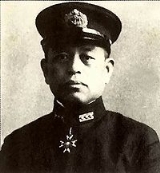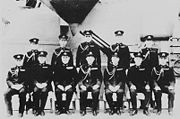
Kosaku Ariga
Encyclopedia

, was a career officer in the Imperial Japanese Navy
Imperial Japanese Navy
The Imperial Japanese Navy was the navy of the Empire of Japan from 1869 until 1947, when it was dissolved following Japan's constitutional renunciation of the use of force as a means of settling international disputes...
during World War II
World War II
World War II, or the Second World War , was a global conflict lasting from 1939 to 1945, involving most of the world's nations—including all of the great powers—eventually forming two opposing military alliances: the Allies and the Axis...
. He commanded the battleship
Battleship
A battleship is a large armored warship with a main battery consisting of heavy caliber guns. Battleships were larger, better armed and armored than cruisers and destroyers. As the largest armed ships in a fleet, battleships were used to attain command of the sea and represented the apex of a...
during its final mission: Operation Ten-Go
Operation Ten-Go
was the last major Japanese naval operation in the Pacific Theater of World War II. Other renderings of this operation's title in English include Operation Heaven One and Ten-ichi-gō....
.
Biography
Aruga was a native of Nagano prefectureNagano Prefecture
is a prefecture of Japan located in the Chūbu region of the island of Honshū. The capital is the city of Nagano.- History :Nagano was formerly known as the province of Shinano...
, and graduated from the 45th class of the Imperial Japanese Navy Academy in 1917, ranked 58th of 89 cadets. He served his midshipman
Midshipman
A midshipman is an officer cadet, or a commissioned officer of the lowest rank, in the Royal Navy, United States Navy, and many Commonwealth navies. Commonwealth countries which use the rank include Australia, New Zealand, South Africa, India, Pakistan, Singapore, Sri Lanka and Kenya...
duty on the cruiser
Cruiser
A cruiser is a type of warship. The term has been in use for several hundreds of years, and has had different meanings throughout this period...
and battleship Hyūga
Japanese battleship Hyuga
Hyūga , named for Hyūga Province in Kyūshū, was an of the Imperial Japanese Navy laid down by Mitsubishi on 6 May 1915, launched on 27 January 1917 and completed on 30 April 1918. She was initially designed as the fourth ship of the , but was heavily redesigned to fix shortcomings...
, and completed naval artillery
Naval artillery
Naval artillery, or naval riflery, is artillery mounted on a warship for use in naval warfare. Naval artillery has historically been used to engage either other ships, or targets on land; in the latter role it is currently termed naval gunfire fire support...
and torpedo
Torpedo
The modern torpedo is a self-propelled missile weapon with an explosive warhead, launched above or below the water surface, propelled underwater towards a target, and designed to detonate either on contact with it or in proximity to it.The term torpedo was originally employed for...
warfare coursework from 1918-1919. After his commissioning as an ensign
Ensign (rank)
Ensign is a junior rank of a commissioned officer in the armed forces of some countries, normally in the infantry or navy. As the junior officer in an infantry regiment was traditionally the carrier of the ensign flag, the rank itself acquired the name....
, he served on a number of destroyer
Destroyer
In naval terminology, a destroyer is a fast and maneuverable yet long-endurance warship intended to escort larger vessels in a fleet, convoy or battle group and defend them against smaller, powerful, short-range attackers. Destroyers, originally called torpedo-boat destroyers in 1892, evolved from...
s. From November 1922-November 1923, he was assigned to the battleship . After his promotion to lieutenant
Lieutenant
A lieutenant is a junior commissioned officer in many nations' armed forces. Typically, the rank of lieutenant in naval usage, while still a junior officer rank, is senior to the army rank...
in December 1923, he served as chief torpedo officer on the destroyer
Destroyer
In naval terminology, a destroyer is a fast and maneuverable yet long-endurance warship intended to escort larger vessels in a fleet, convoy or battle group and defend them against smaller, powerful, short-range attackers. Destroyers, originally called torpedo-boat destroyers in 1892, evolved from...
s and , followed by the light cruiser
Light cruiser
A light cruiser is a type of small- or medium-sized warship. The term is a shortening of the phrase "light armored cruiser", describing a small ship that carried armor in the same way as an armored cruiser: a protective belt and deck...
s and .
After his promotion to lieutenant commander
Lieutenant Commander
Lieutenant Commander is a commissioned officer rank in many navies. The rank is superior to a lieutenant and subordinate to a commander...
in 1929, Aruga received his first command; the destroyer . This was followed by in 1930, , Akikaze in 1932, in 1933 and in 1934. After a shore assignment to the Chinkai Guard District
Chinkai Guard District
The was the major navy base for the Imperial Japanese Navy in Korea under Japanese rule before and during World War II. Located in southern Korea , the Chinkai Guard District was responsible for control of the strategic Straits of Shimonoseki and for patrols along the Korean coastline and in the...
from 1935–1937, Aruga returned to sea as the executive officer
Executive officer
An executive officer is generally a person responsible for running an organization, although the exact nature of the role varies depending on the organization.-Administrative law:...
on the cruiser . He subsequently commanded a Minesweeper Division and Destroyer Division 11 (DesDiv 4), and was promoted to captain
Captain (naval)
Captain is the name most often given in English-speaking navies to the rank corresponding to command of the largest ships. The NATO rank code is OF-5, equivalent to an army full colonel....
in November 1940.
In June 1941, Aruga was in command of DesDiv 4, which participated in the Battle of Midway
Battle of Midway
The Battle of Midway is widely regarded as the most important naval battle of the Pacific Campaign of World War II. Between 4 and 7 June 1942, approximately one month after the Battle of the Coral Sea and six months after Japan's attack on Pearl Harbor, the United States Navy decisively defeated...
and in the Battle of the Eastern Solomons
Battle of the Eastern Solomons
The naval Battle of the Eastern Solomons The naval Battle of the Eastern Solomons The naval Battle of the Eastern Solomons (also known as the Battle of the Stewart Islands and, in Japanese sources, as the , took place on 24–25 August 1942, and was the third carrier battle of the Pacific campaign...
.
In March 1943, Aruga was reassigned to command the heavy cruiser
Heavy cruiser
The heavy cruiser was a type of cruiser, a naval warship designed for long range, high speed and an armament of naval guns roughly 203mm calibre . The heavy cruiser can be seen as a lineage of ship design from 1915 until 1945, although the term 'heavy cruiser' only came into formal use in 1930...
. Recalled to Japan in June 1944 after he developed malaria
Malaria
Malaria is a mosquito-borne infectious disease of humans and other animals caused by eukaryotic protists of the genus Plasmodium. The disease results from the multiplication of Plasmodium parasites within red blood cells, causing symptoms that typically include fever and headache, in severe cases...
, Aruga served as chief instructor at the Torpedo School until November of that year, when he was reassigned to the IJN 2nd Fleet
IJN 2nd Fleet
The was a fleet of the Imperial Japanese Navy.-History:First established on 28 December 1903, the IJN 2nd Fleet was created by the Imperial General Headquarters as a mobile strike force of cruisers and destroyers to pursue the Imperial Russian Navy's Vladivostok-based cruiser squadron while the...
. On 25 November 1944, he was given command of the battleship .
In April 1945, under Operation-Ten Gō
Operation Ten-Go
was the last major Japanese naval operation in the Pacific Theater of World War II. Other renderings of this operation's title in English include Operation Heaven One and Ten-ichi-gō....
, Yamato was assigned on a suicide mission against the American forces at the Battle of Okinawa
Battle of Okinawa
The Battle of Okinawa, codenamed Operation Iceberg, was fought on the Ryukyu Islands of Okinawa and was the largest amphibious assault in the Pacific War of World War II. The 82-day-long battle lasted from early April until mid-June 1945...
, given only enough fuel for a one-way mission and only a cruiser and eight destroyers as an escort. Yamato was to wreak havoc on the American landing operation, and to beach herself on the Okinawa shore as a coastal fortress. On April 7, 1945, Yamato was sunk by waves of U.S. Navy
United States Navy
The United States Navy is the naval warfare service branch of the United States Armed Forces and one of the seven uniformed services of the United States. The U.S. Navy is the largest in the world; its battle fleet tonnage is greater than that of the next 13 largest navies combined. The U.S...
carrier-based aircraft. Aruga went down with his ship. He was posthumously promoted two steps in rank to vice admiral
Vice Admiral
Vice admiral is a senior naval rank of a three-star flag officer, which is equivalent to lieutenant general in the other uniformed services. A vice admiral is typically senior to a rear admiral and junior to an admiral...
.
In Film
- In ToeiToei Companyis a Japanese film, television production, and distribution corporation. Based in Tokyo, Toei owns and operates thirty-four movie theaters across Japan, a modest vertically-integrated studio system by the standards of the 1930s United States; operates studios at Tokyo and Kyoto; and is a...
's 2005 war film Yamato (男たちの大和 Otokotachi no Yamato), Aruga was portrayed by award-winning actor Eiji OkudaEiji Okudais a Japanese actor and film director. Born in Kasugai, Aichi, he was nominated for the Best Actor award at the 1990 Japanese Academy Awards for his performance in Sen no Rikyu...
.
- In Shūe Matsubayashi's 1981 war film Rengō Kantai 連合艦隊 (lit. "Combined Fleet", later released as "The Imperial Navy"), Aruga was portrayed by Koji TsurutaKoji Tsurutawas a Japanese actor who appeared in almost 260 feature films.-Career:Born in Shizuoka Prefecture as Eiichi Ono, Tsuruta was studying at Kansai University when he was drafted into the Japanese Imperial Navy. After the war he joined Kōkichi Takada's theater troupe and made his film debut at Shochiku...
.
- In Shūe Matsubayashi's 1963 film Taiheiyo no tsubasa (太平洋の翼 T, lit. "Wings Over the Pacific", later released in the United States under the titles "Attack Squadron!" and "Kamikaze"), Aruga was portrayed by Seizaburô Kawazu.
- In Yutaka AbeYutaka Abewas a Japanese film director and actor. He went to America to study theater and began acting in Hollywood, appearing in such films as The Cheat with Sessue Hayakawa. He was often billed as "Jack Abbe" or "Jack Yutake Abbe." He returned to Japan in 1925, finding work at the Nikkatsu studio, and soon...
's 1953 film Senkan Yamato, Aruga was portrayed by Takamaru Sasaki.
Spelling of last name
Some sources render his last name as Ariga; the difference is due to an alternate reading of the first kanjiKanji
Kanji are the adopted logographic Chinese characters hanzi that are used in the modern Japanese writing system along with hiragana , katakana , Indo Arabic numerals, and the occasional use of the Latin alphabet...
character in his family name.

